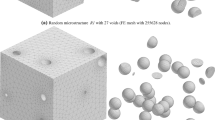Abstract
The dependence of ductile, microvoid fracture on the size and distribution of voids or pores has been modeled experimentally. Pores or voids have been physically modeled in two dimensions by both random and regular arrays of equi-sized holes drilled through the thickness of tensile specimens of 1100-0 Al sheet and 7075-T6 Al plate and sheet. Fracture strains as well as failure paths have been determined for different hole sizes, spacings, and area fractions. A statistical analysis of the data indicates that increasing the minimum hole spacing, which decreases the degree of hole clustering, increases both strength and ductility. Conversely, decreasing the hole size causes a minor increase in both strength and ductility. Increasing the rate of work hardening is beneficial to ductility in that a high strain hardening rate appears to increase the resistance to flow localization between holes. The results are discussed in terms of a fracture process which depends on shear localization between holes/voids and which is very sensitive to void/pore distributions.
Similar content being viewed by others
References
R. Haynes:The Mechanical Behavior of Sintered Alloys, Freund Publishing House, London, 1981.
I. G. Palmer and G. C. Smith: inProc. Second Bolton Landing Conf. on Oxide Dispersion Strengthening, Gordon and Breach, New York, NY, 1968, pp. 253.
T. B. Cox and J.R. Low.Metall. Trans., 1973, vol. 5, p. 1457.
R. H. Van Stone, R. H. Merchant, and J. R. Low: in ASTM STP 556, 1974, p. 53.
F. A. McClintock:J. Appl. Mech., 1968, vol. 35, p. 363.
D. M. Tracey:Eng. Frac. Mech., 1971, vol. 3, p. 301.
A. Needleman:J. Appl. Mech., 1972, vol. 39, p. 964.
P. F. Thomason:Acta Metall., 1981, vol. 29, p. 763.
P. F. Thomason:Acta Metall., 1985, vol. 33, pp. 1079 and 1087.
V. Tvergaard:J. Mech. Phys. Solids, 1982, vol. 30, p. 265.
V. Tvergaard:Int. J. Frac., 1981, vol. 17, p. 389.
A. Melander:Mat’l. Sci. and Eng., 1979, vol. 39, p. 57.
A. Melander and U. Stahlberg:Int. J. Frac., 1980, vol. 16, p. 431.
A. Melander:Acta Metall., 1980, vol. 28, p. 1799.
M. Nagumo:Acta Metall., 1973, vol. 21, p. 1661.
G. Box, W. Hunter, and J. Hunter:Statistics for Experimenters, J. Wiley & Sons, New York, NY, 1978, p. 306.
E. M. Dubensky and D. A. Koss: inAluminum Alloys—Their Physical and Mechanical Properties, Engineering Materials Advisory Services, Ltd., Warley, U.K., 1986, p. 999.
P. E. Magnusen, Michigan Technological University, D. Srolovitz, Los Alamos National Laboratory, and D. A. Koss, The Pennsylvania State University, unpublished research, 1987.
E. M. Dubensky: M. S. Thesis, Michigan Technological University, 1985.
S. C. Choi:Introductory Applied Statistics in Science, Prentice-Hall, Englewood Cliffs, NJ, 1978.
P. S. Merril:Proc. SESA, 1961, vol. 18, p. 73.
R. I. Bourcier, R. E. Smelser, O. Richmond, and D. A. Koss:Int. J. Frac, 1984, vol. 24, p. 289.
R. J. Bourcier and D. A. Koss: inAdvances in Fracture Research, Pergamon Press, New York, NY, 1980, p. 187.
P. E. Magnusen and J. K. Lee, Michigan Technological University, and D. A. Koss, The Pennsylvania State University, unpublished research, 1986.
P. E. Magnusen, E. M. Dubensky, and D. A. Koss: Technical Report No. 5, Office of Naval Research Contract No. N00014-86-K-0381, Jan. 1987.
D. Teirlinck, M. F Ashby, and J. D. Embury: inProc 6th International Conference on Fracture, Bangalore, India, 1984.
R. J. Bourcier, D. A. Koss, R. E. Smelser, and O. Richmond:Acta Metall., 1986, vol. 34, p. 2443.
B.I. Edelson:Trans. ASM, 1963, vol. 56, p. 89.
A. J. Durelli and V. J. Parks:Moiré Analysis of Strain, Prentice-Hall, Englewood Cliffs, NJ, 1970, p. 302.
H. Yamamoto:Int. J. Frac, 1978, vol. 14, p. 347.
M. Saje, J. Pan, and A. Needleman:Int. J. Frac, 1982, vol. 19, p. 163.
Author information
Authors and Affiliations
Additional information
This paper is based on a presentation made at the symposium “Stochastic Aspects of Fracture” held at the 1986 annual AIME meeting in New Orleans, LA, on March 2-6, 1986, under the auspices of the ASM/MSD Flow and Fracture Committee.
Rights and permissions
About this article
Cite this article
Dubensky, E.M., Koss, D.A. Void/pore distributions and ductile fracture. Metall Trans A 18, 1887–1895 (1987). https://doi.org/10.1007/BF02647018
Issue Date:
DOI: https://doi.org/10.1007/BF02647018




